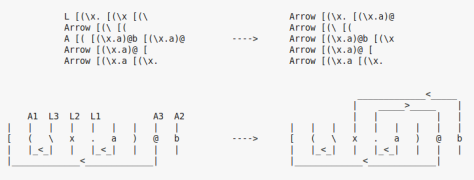Zipper logic is an alternative to chemlambda, where two patterns of nodes, called half-zippers, appear.
It may be more easy to mimic, from a molecular point of view.
Anyway, if you want to have a clear image about how it works then there are two ways to play with zippers.
1. Go to this page and execute a zip move. Is that a zipper or not?
2. Go to the lambda2chemlambda page and type this lambda term
(\h.\g.\f.\e.\d.\c.\b.\a.z) A B C D E F G H
Then reduce it. [There is a difference, because a, b, … h do not occur in A B C D E F so the parser adds a termination node to each of them, so when you reduce it the zipper will zip and then will dissappear.]
You can see here the half-zippers
\h.\g.\f.\e.\d.\c.\b.\a.
A B C D E F G H
which are the inspiration of the zippers from zipper logic.
In chemlambda you can also make FI-zippers and FOE-zippers as well, I used this for permutations.
BONUS: I made a comment at HN which received the funny reply “Thanks for the nightmares! 🙂“, so let me recall, by way of this comment, what is an Ackermann goo:
A scenario more interesting than boundless self-replication is Ackermann goo [0], [1]. Grey goo starts with a molecular machine able to replicate itself. You get exponentially more copies, hence goo. Imagine that we could build molecules like programs which execute themselves via chemical interactions with the environment. Then, for example, a Y combinator machine would appear as a linearly growing string [2]. No danger here. Take Ackermann(4,4) now. This is vastly more complex than a goo made of lots of small dumb copies.
[0] https://chemlambda.github.io/collection.html#58
[1] https://chemlambda.github.io/collection.html#59
[2] https://chemlambda.github.io/collection.html#259
